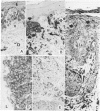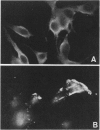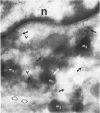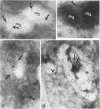Abstract
A monoclonal antibody, NKI/beteb, was prepared against membranes from a human melanoma metastasis, and in immunoprecipitates of melanoma cell lysates specific 100- and 7-kd glycoproteins were found. The large glycoproteins were also present in conditioned medium of melanoma cell lines. The antigen is located on the inner side of membranes of (pre)melanosomes and premelanosomelike vesicles. The antibody reacted in the immunoperoxidase test on frozen tissue sections with 27 of 28 nevocellular nevi (15/16 common, 12/12 dysplastic), 39/39 primary melanomas (3 intraepidermal, 24 cutaneous, 12 choroidal), 56/63 melanoma metastases, and 4/4 clear-cell sarcomas (melanoma of soft tissue). With sections of formalin-fixed paraffin-embedded tissues, the reaction was less sensitive. No reactivity was detected with frozen sections of 185 other tumors, except for 1 case of non-Hodgkin's lymphoma in which macrophages were positive. With the exception of melanocytes, all frozen sections of adult tissues that were tested were negative with NKI/beteb. On the basis of its tissue distribution so far, the antigen recognized by NKI/beteb seems to be a specific and sensitive diagnostic marker for cells of the melanocyte lineage.
Full text
PDF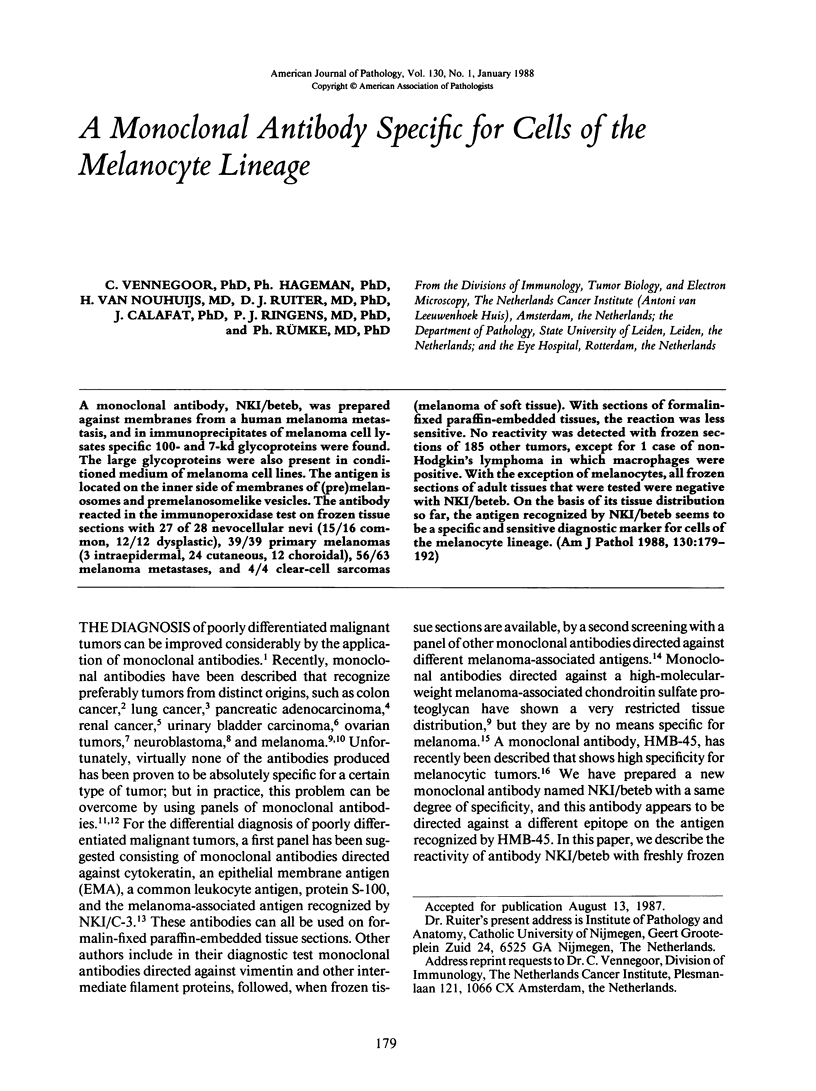
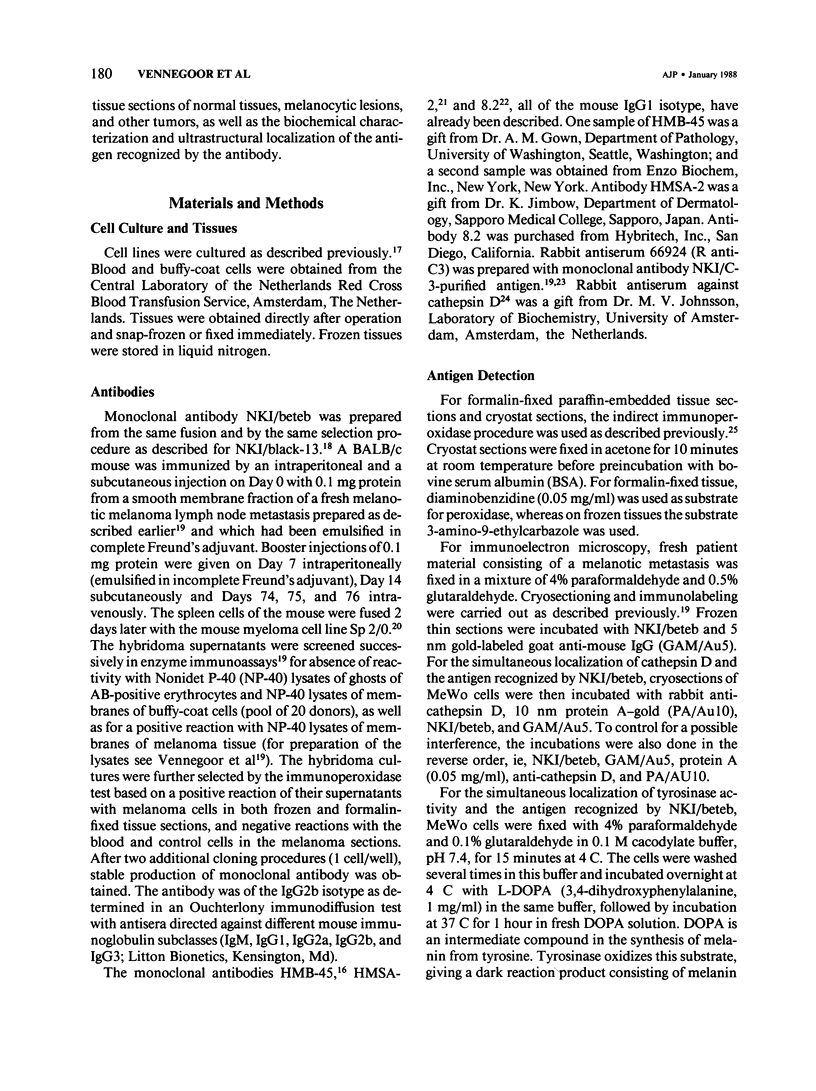
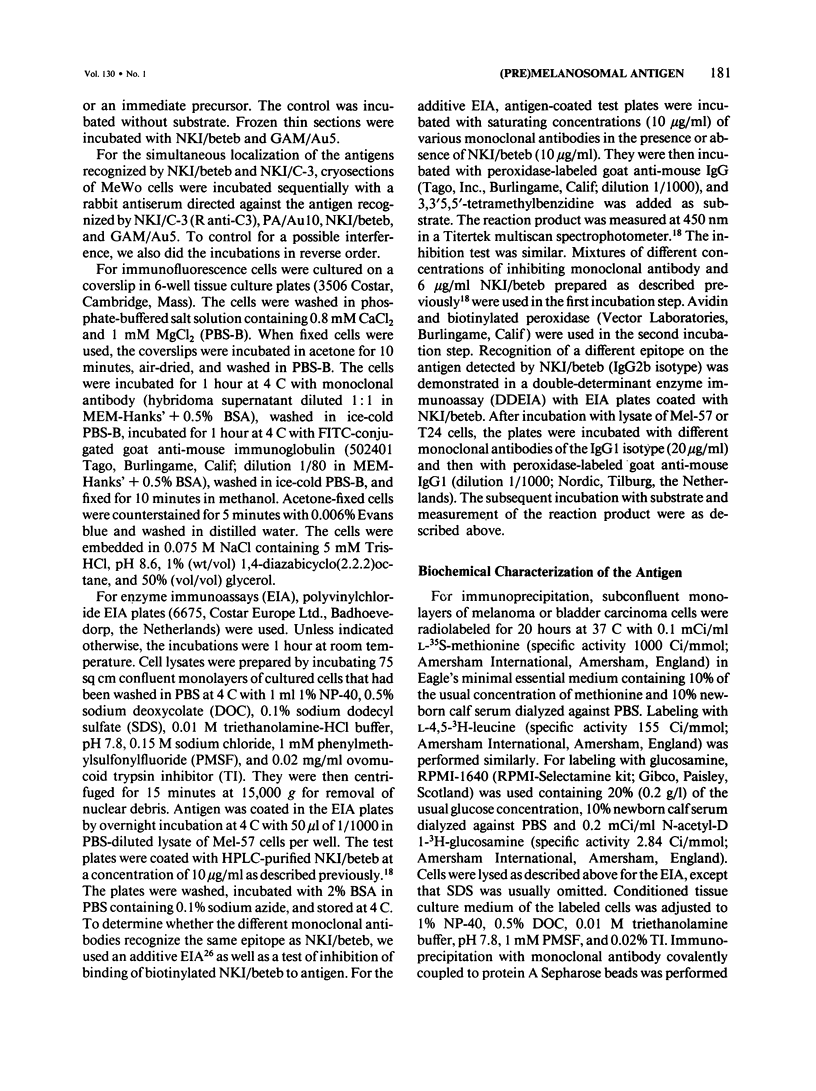
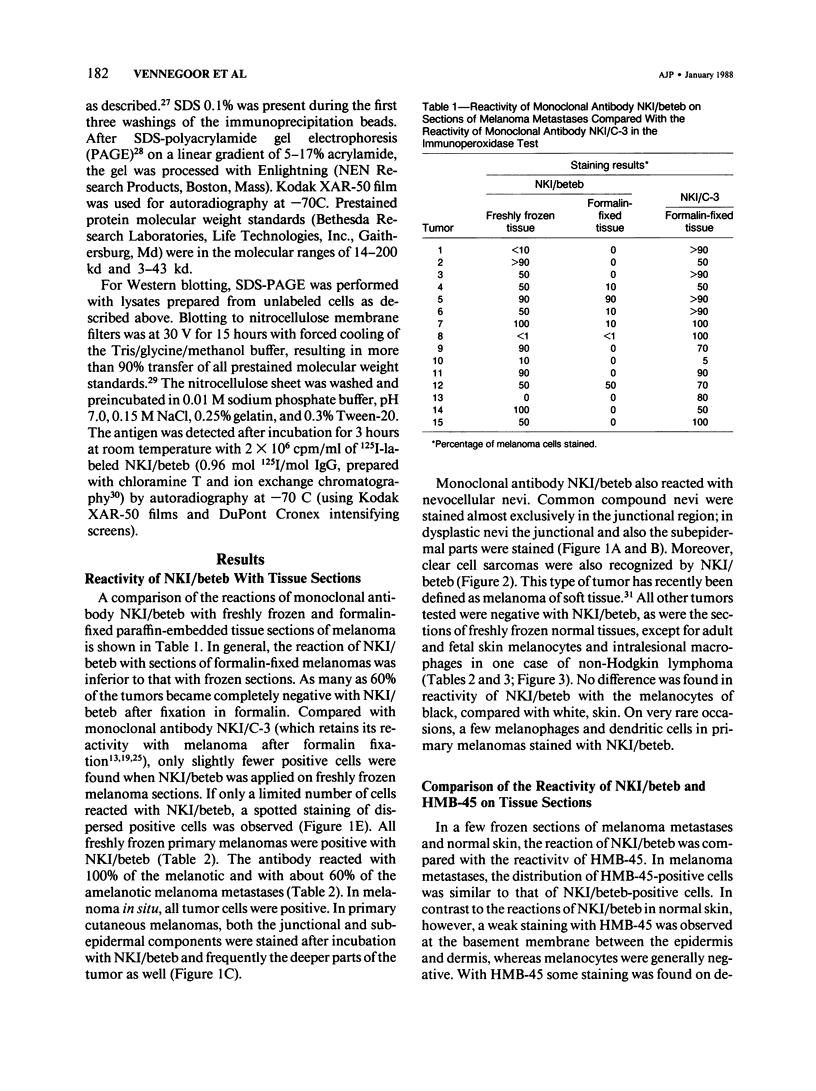
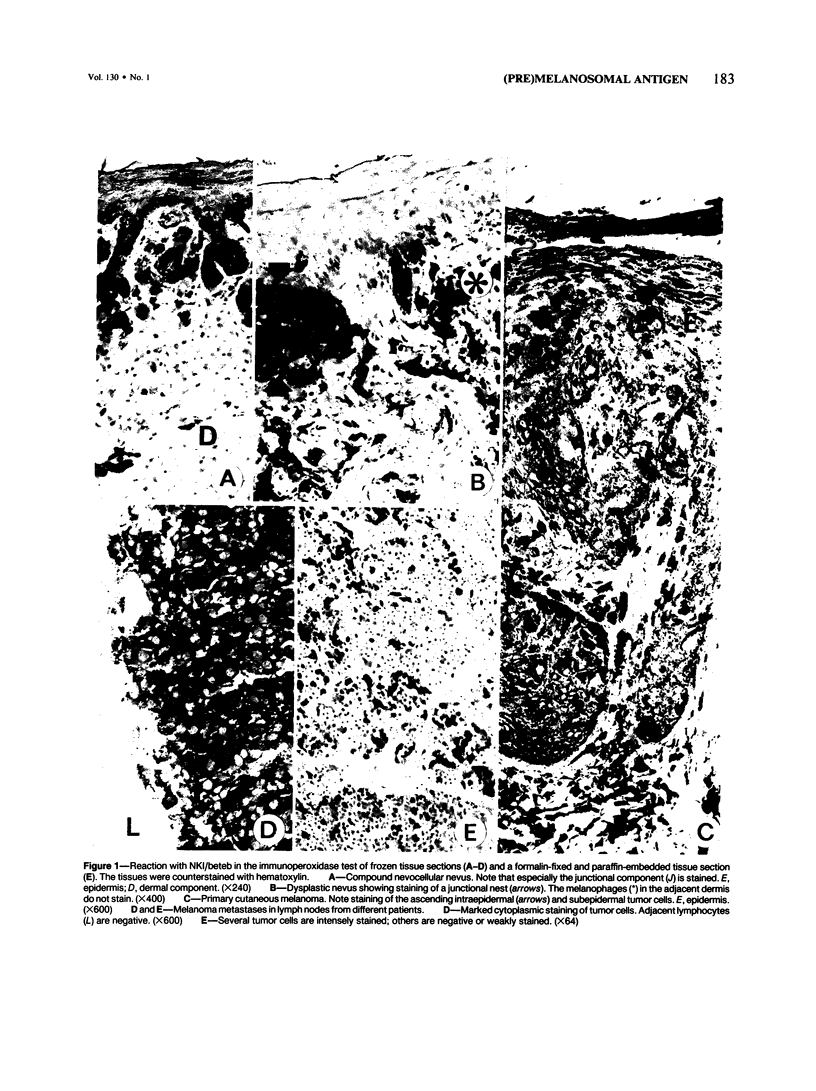
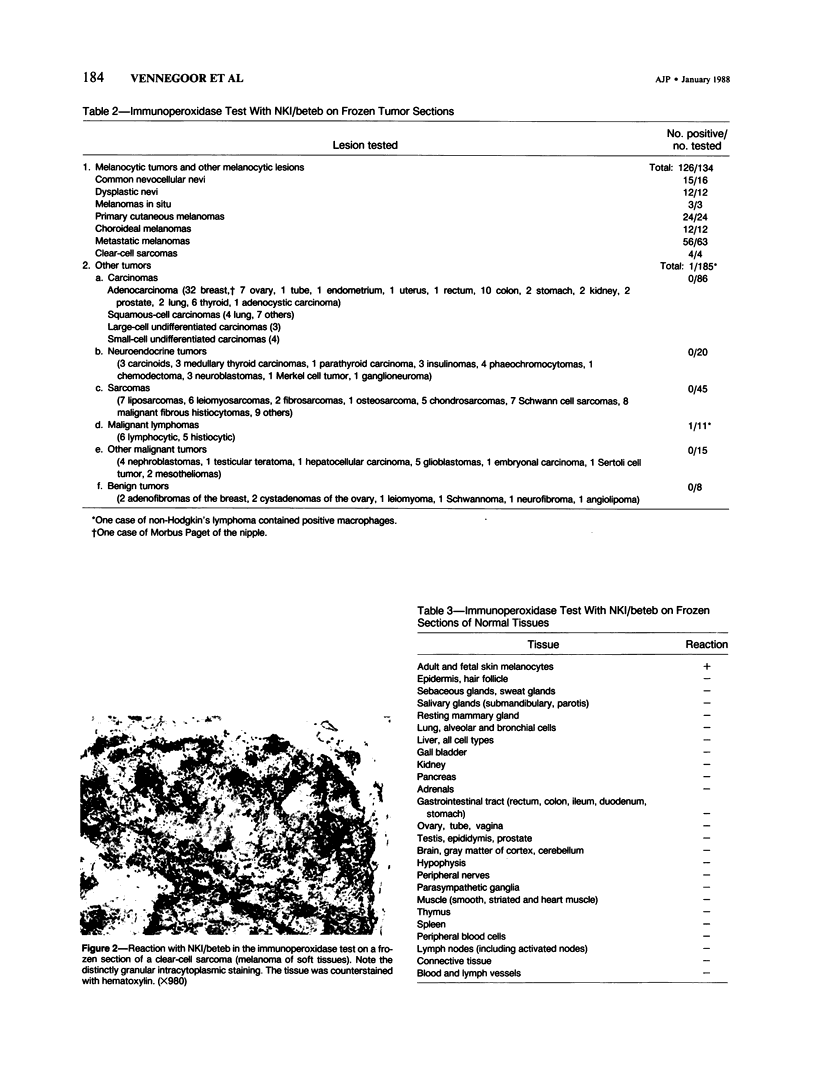
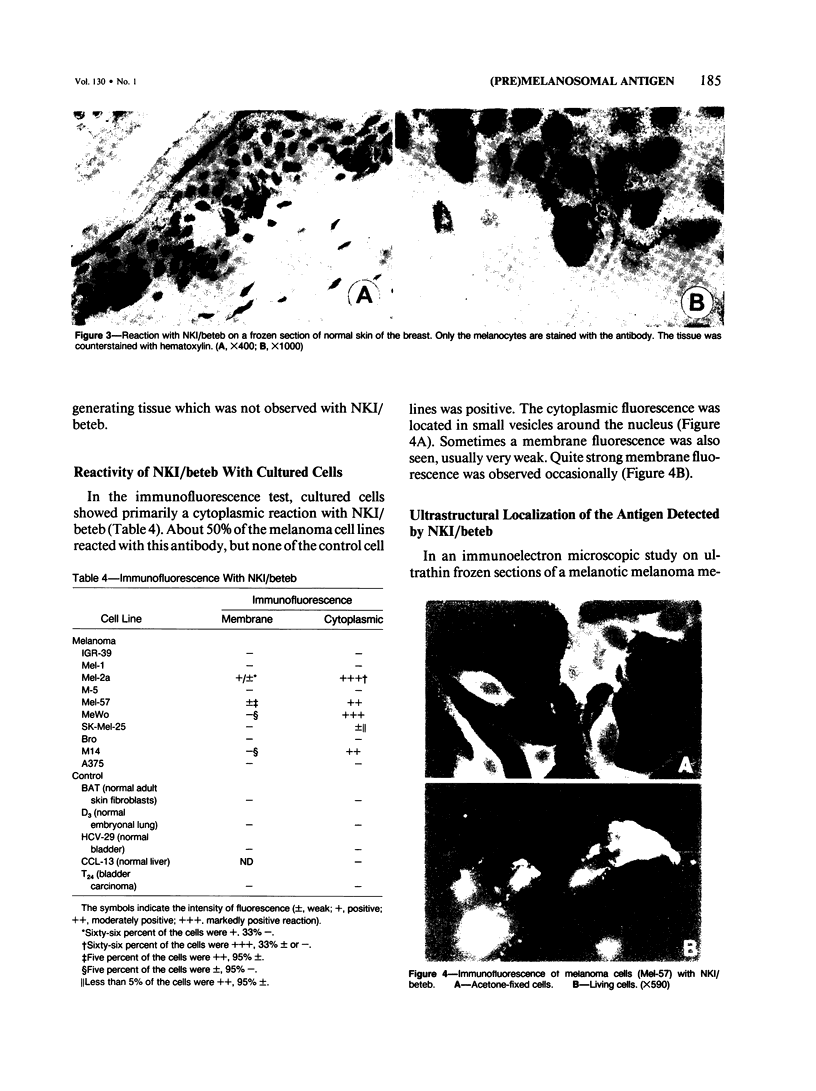
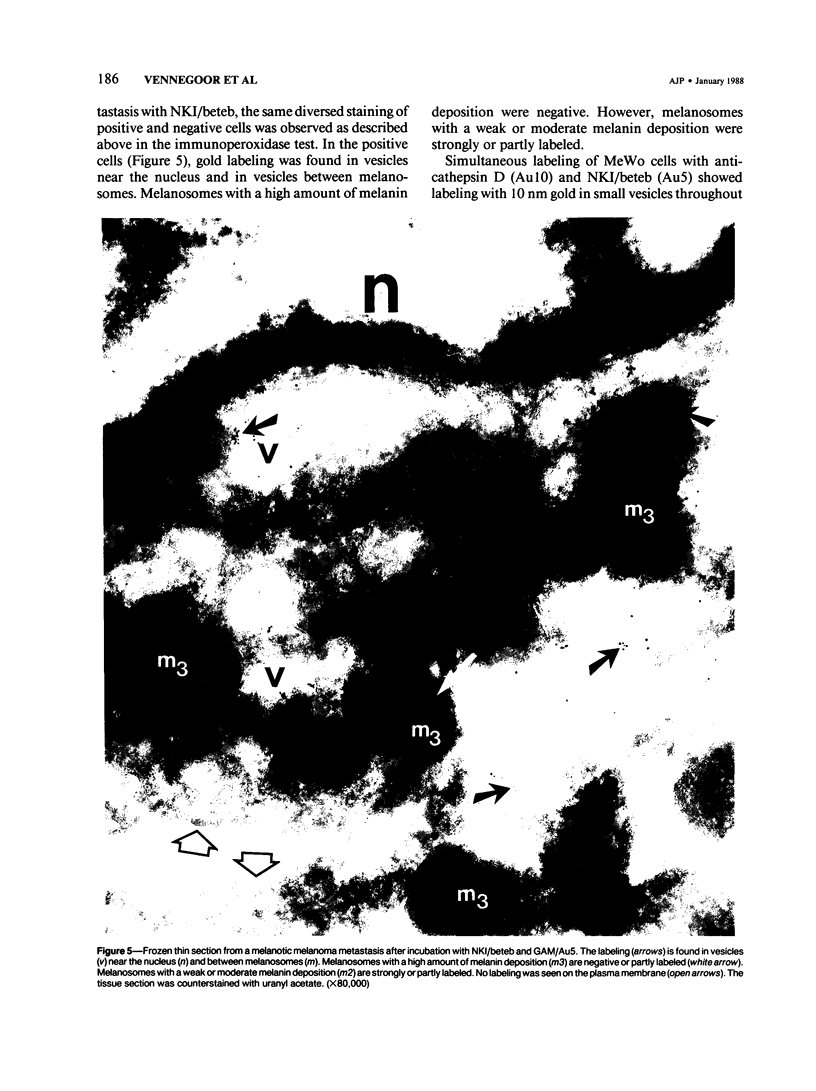
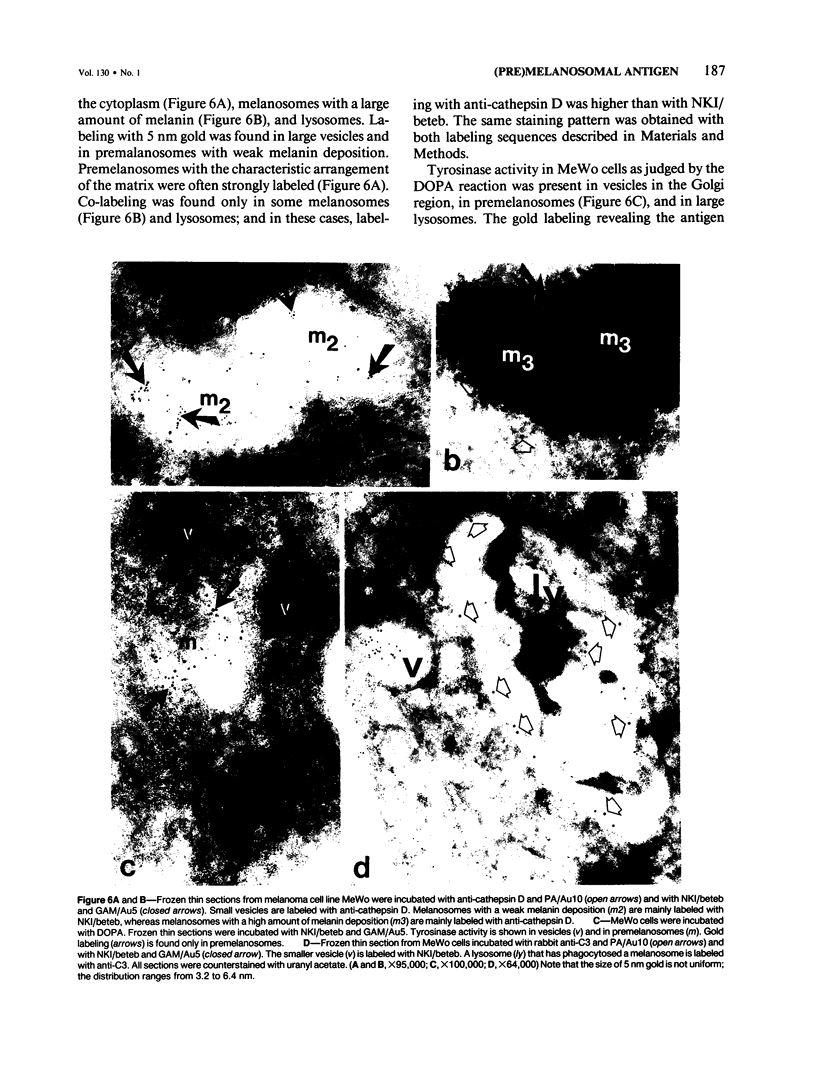
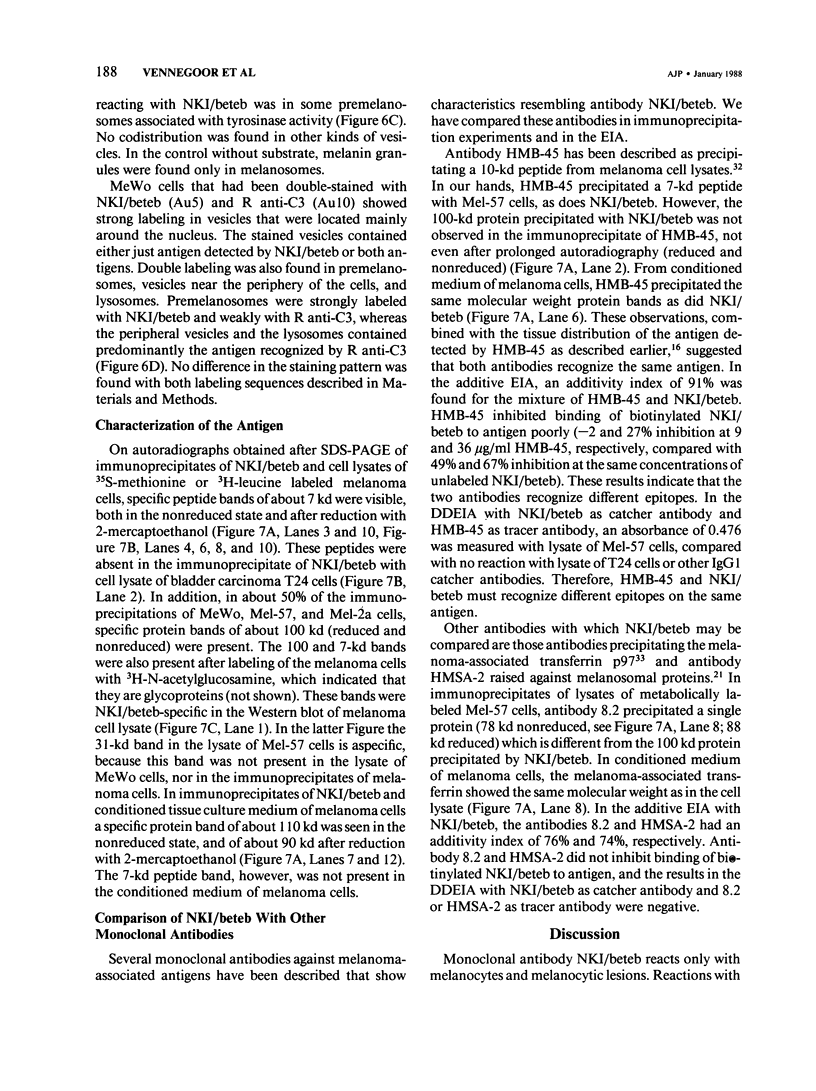
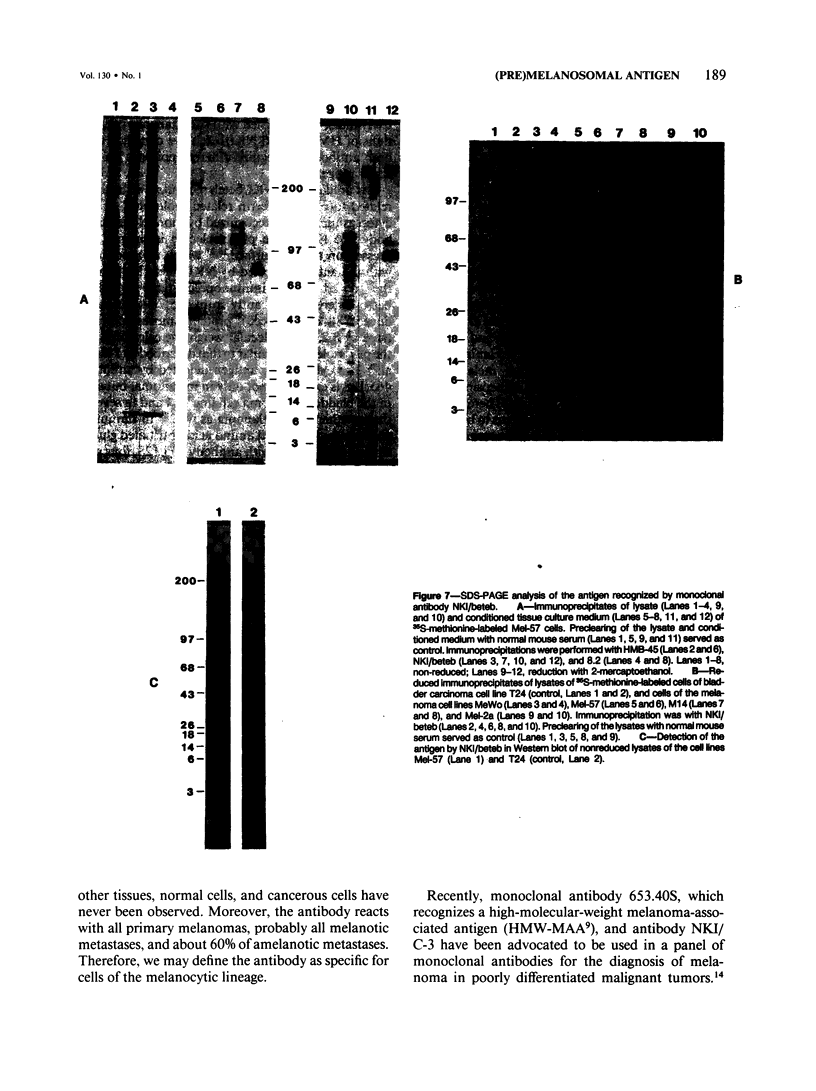
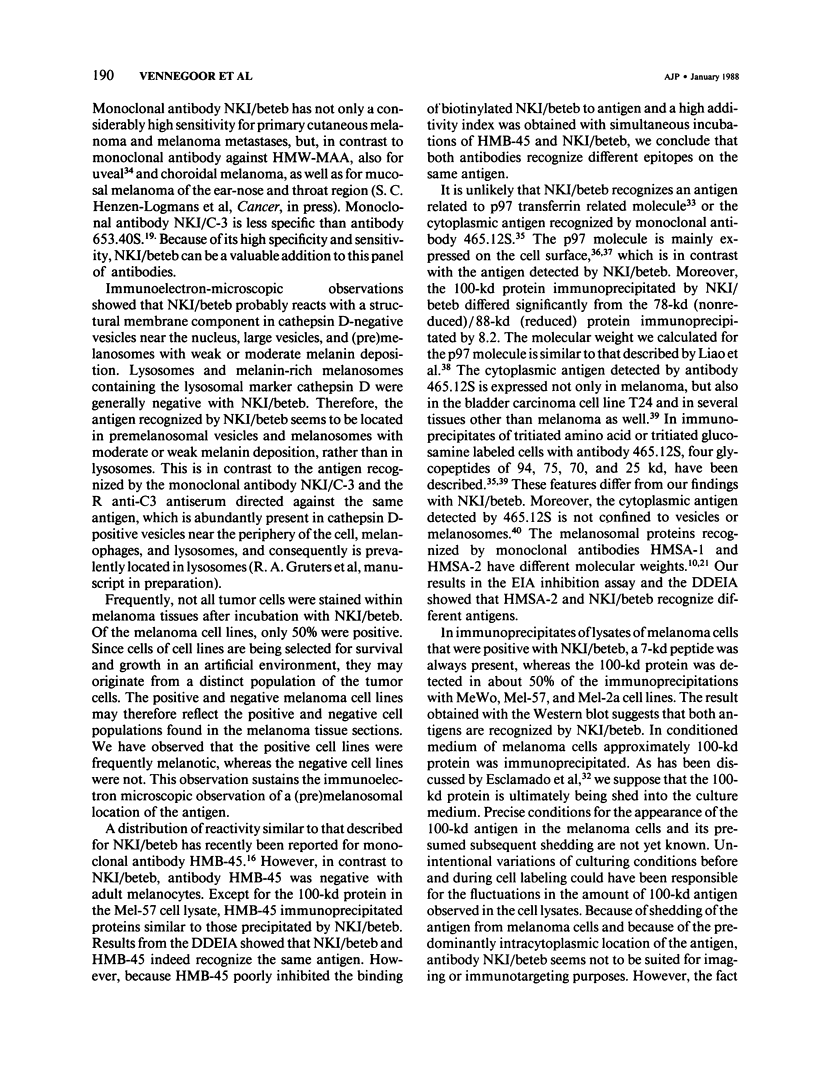
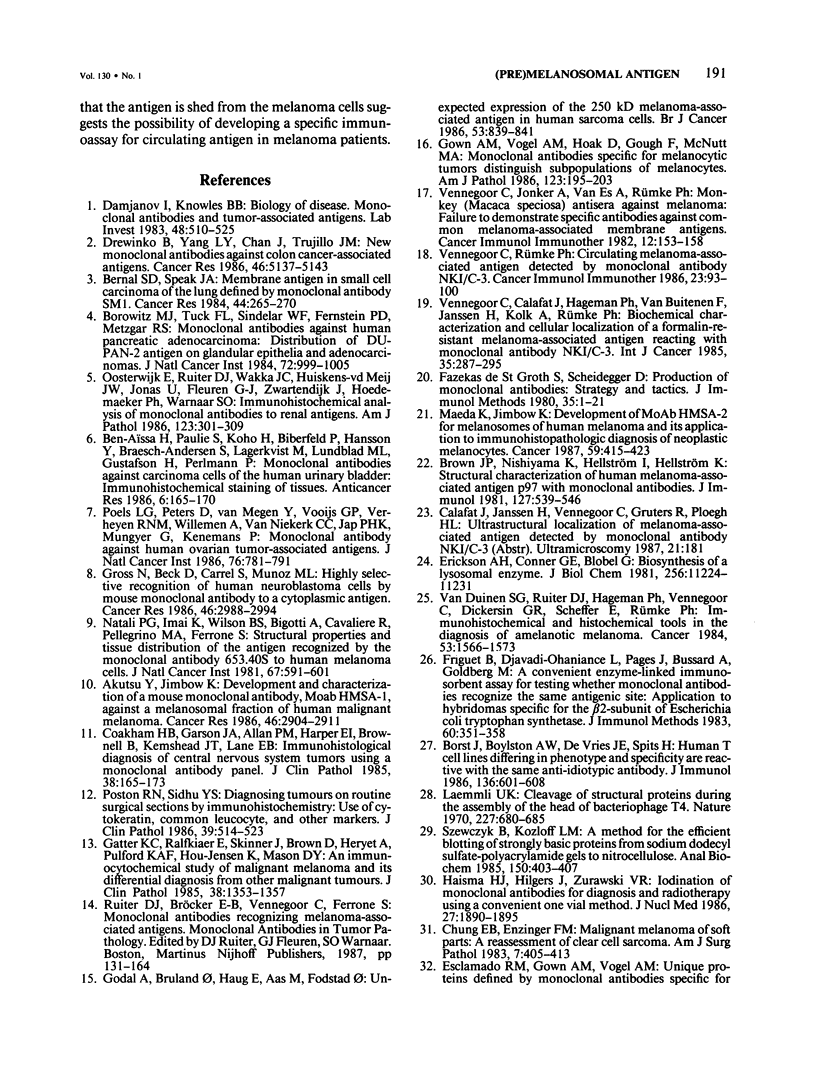
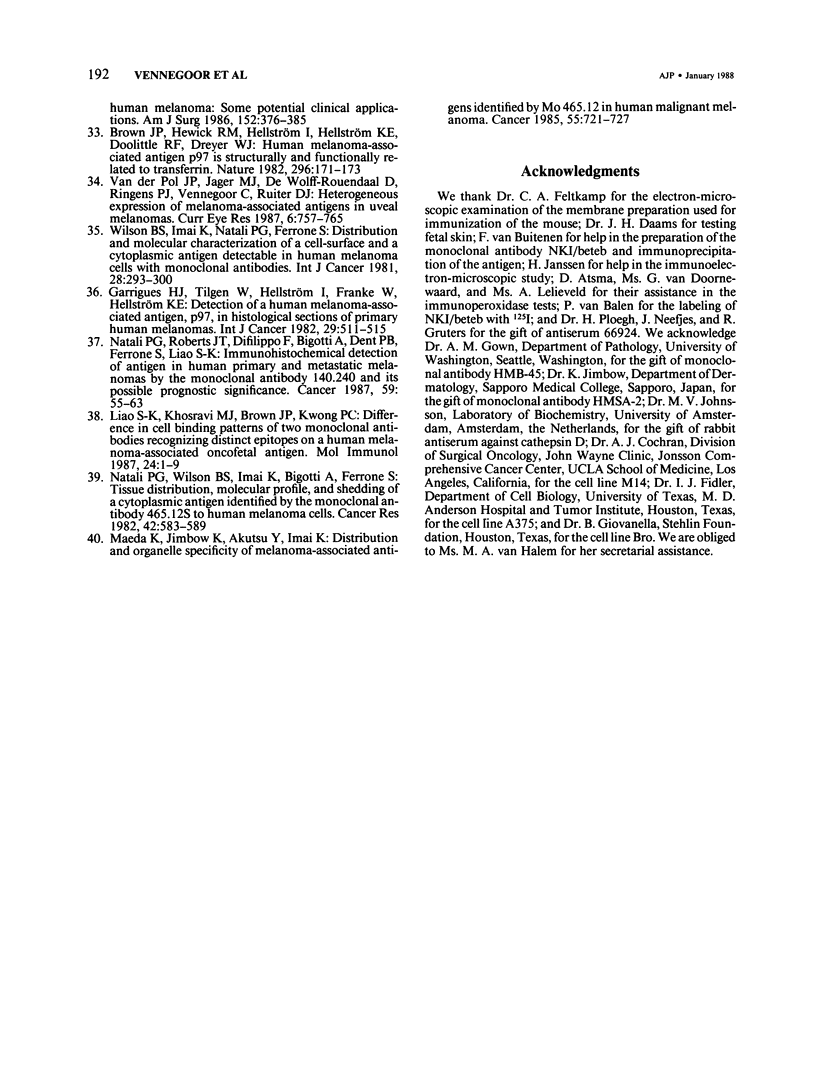
Images in this article
Selected References
These references are in PubMed. This may not be the complete list of references from this article.
- Akutsu Y., Jimbow K. Development and characterization of a mouse monoclonal antibody, MoAb HMSA-1, against a melanosomal fraction of human malignant melanoma. Cancer Res. 1986 Jun;46(6):2904–2911. [PubMed] [Google Scholar]
- Ben-Aïssa H., Paulie S., Koho H., Biberfeld P., Hansson Y., Braesch-Andersen S., Lagerkvist M., Lundblad M. L., Gustafson H., Perlmann P. Monoclonal antibodies against carcinoma cells of the human urinary bladder: immunohistochemical staining of tissues. Anticancer Res. 1986 Mar-Apr;6(2):165–170. [PubMed] [Google Scholar]
- Bernal S. D., Speak J. A. Membrane antigen in small cell carcinoma of the lung defined by monoclonal antibody SM1. Cancer Res. 1984 Jan;44(1):265–270. [PubMed] [Google Scholar]
- Borowitz M. J., Tuck F. L., Sindelar W. F., Fernsten P. D., Metzgar R. S. Monoclonal antibodies against human pancreatic adenocarcinoma: distribution of DU-PAN-2 antigen on glandular epithelia and adenocarcinomas. J Natl Cancer Inst. 1984 May;72(5):999–1005. [PubMed] [Google Scholar]
- Borst J., Boylston A. W., de Vries J. E., Spits H. Human T cell lines differing in phenotype and specificity are reactive with the same anti-idiotypic antibody. J Immunol. 1986 Jan;136(2):601–608. [PubMed] [Google Scholar]
- Brown J. P., Hewick R. M., Hellström I., Hellström K. E., Doolittle R. F., Dreyer W. J. Human melanoma-associated antigen p97 is structurally and functionally related to transferrin. Nature. 1982 Mar 11;296(5853):171–173. doi: 10.1038/296171a0. [DOI] [PubMed] [Google Scholar]
- Brown J. P., Nishiyama K., Hellström I., Hellström K. E. Structural characterization of human melanoma-associated antigen p97 with monoclonal antibodies. J Immunol. 1981 Aug;127(2):539–546. [PubMed] [Google Scholar]
- Chung E. B., Enzinger F. M. Malignant melanoma of soft parts. A reassessment of clear cell sarcoma. Am J Surg Pathol. 1983 Jul;7(5):405–413. doi: 10.1097/00000478-198307000-00003. [DOI] [PubMed] [Google Scholar]
- Coakham H. B., Garson J. A., Allan P. M., Harper E. I., Brownell B., Kemshead J. T., Lane E. B. Immunohistological diagnosis of central nervous system tumours using a monoclonal antibody panel. J Clin Pathol. 1985 Feb;38(2):165–173. doi: 10.1136/jcp.38.2.165. [DOI] [PMC free article] [PubMed] [Google Scholar]
- Damjanov I., Knowles B. B. Biology of disease. Monoclonal antibodies and tumor-associated antigens. Lab Invest. 1983 May;48(5):510–525. [PubMed] [Google Scholar]
- Drewinko B., Yang L. Y., Chan J., Trujillo J. M. New monoclonal antibodies against colon cancer-associated antigens. Cancer Res. 1986 Oct;46(10):5137–5143. [PubMed] [Google Scholar]
- Erickson A. H., Conner G. E., Blobel G. Biosynthesis of a lysosomal enzyme. Partial structure of two transient and functionally distinct NH2-terminal sequences in cathepsin D. J Biol Chem. 1981 Nov 10;256(21):11224–11231. [PubMed] [Google Scholar]
- Esclamado R. M., Gown A. M., Vogel A. M. Unique proteins defined by monoclonal antibodies specific for human melanoma. Some potential clinical applications. Am J Surg. 1986 Oct;152(4):376–385. doi: 10.1016/0002-9610(86)90308-9. [DOI] [PubMed] [Google Scholar]
- Friguet B., Djavadi-Ohaniance L., Pages J., Bussard A., Goldberg M. A convenient enzyme-linked immunosorbent assay for testing whether monoclonal antibodies recognize the same antigenic site. Application to hybridomas specific for the beta 2-subunit of Escherichia coli tryptophan synthase. J Immunol Methods. 1983 Jun 10;60(3):351–358. doi: 10.1016/0022-1759(83)90292-2. [DOI] [PubMed] [Google Scholar]
- Garrigues H. J., Tilgen W., Hellstróm I., Franke W., Hellström K. E. Detection of a human melanoma-associated antigen, p97, in histological sections of primary human melanomas. Int J Cancer. 1982 May 15;29(5):511–515. doi: 10.1002/ijc.2910290505. [DOI] [PubMed] [Google Scholar]
- Gatter K. C., Ralfkiaer E., Skinner J., Brown D., Heryet A., Pulford K. A., Hou-Jensen K., Mason D. Y. An immunocytochemical study of malignant melanoma and its differential diagnosis from other malignant tumours. J Clin Pathol. 1985 Dec;38(12):1353–1357. doi: 10.1136/jcp.38.12.1353. [DOI] [PMC free article] [PubMed] [Google Scholar]
- Godal A., Bruland O., Haug E., Aas M., Fodstad O. Unexpected expression of the 250 kD melanoma-associated antigen in human sarcoma cells. Br J Cancer. 1986 Jun;53(6):839–841. doi: 10.1038/bjc.1986.142. [DOI] [PMC free article] [PubMed] [Google Scholar]
- Gown A. M., Vogel A. M., Hoak D., Gough F., McNutt M. A. Monoclonal antibodies specific for melanocytic tumors distinguish subpopulations of melanocytes. Am J Pathol. 1986 May;123(2):195–203. [PMC free article] [PubMed] [Google Scholar]
- Gross N., Beck D., Carrel S., Munoz M. Highly selective recognition of human neuroblastoma cells by mouse monoclonal antibody to a cytoplasmic antigen. Cancer Res. 1986 Jun;46(6):2988–2994. [PubMed] [Google Scholar]
- Haisma H. J., Hilgers J., Zurawski V. R., Jr Iodination of monoclonal antibodies for diagnosis and radiotherapy using a convenient one vial method. J Nucl Med. 1986 Dec;27(12):1890–1895. [PubMed] [Google Scholar]
- Laemmli U. K. Cleavage of structural proteins during the assembly of the head of bacteriophage T4. Nature. 1970 Aug 15;227(5259):680–685. doi: 10.1038/227680a0. [DOI] [PubMed] [Google Scholar]
- Liao S. K., Khosravi M. J., Brown J. P., Kwong P. C. Difference in cell binding patterns of two monoclonal antibodies recognizing distinct epitopes on a human melanoma-associated oncofetal antigen. Mol Immunol. 1987 Jan;24(1):1–9. doi: 10.1016/0161-5890(87)90105-2. [DOI] [PubMed] [Google Scholar]
- Maeda K., Jimbow K., Akutsu Y., Imai K. Distribution and organelle specificity of melanoma-associated antigens identified by Mo 465.12 in human malignant melanoma. Cancer. 1985 Feb 15;55(4):721–727. doi: 10.1002/1097-0142(19850215)55:4<721::aid-cncr2820550408>3.0.co;2-f. [DOI] [PubMed] [Google Scholar]
- Maeda K., Jimbow K. Development of MoAb HMSA-2 for melanosomes of human melanoma and its application to immunohistopathologic diagnosis of neoplastic melanocytes. Cancer. 1987 Feb 1;59(3):415–423. doi: 10.1002/1097-0142(19870201)59:3<415::aid-cncr2820590311>3.0.co;2-k. [DOI] [PubMed] [Google Scholar]
- Natali P. G., Imai K., Wilson B. S., Bigotti A., Cavaliere R., Pellegrino M. A., Ferrone S. Structural properties and tissue distribution of the antigen recognized by the monoclonal antibody 653.40S to human melanoma cells. J Natl Cancer Inst. 1981 Sep;67(3):591–601. [PubMed] [Google Scholar]
- Natali P. G., Roberts J. T., Difilippo F., Bigotti A., Dent P. B., Ferrone S., Liao S. K. Immunohistochemical detection of antigen in human primary and metastatic melanomas by the monoclonal antibody 140.240 and its possible prognostic significance. Cancer. 1987 Jan 1;59(1):55–63. doi: 10.1002/1097-0142(19870101)59:1<55::aid-cncr2820590115>3.0.co;2-r. [DOI] [PubMed] [Google Scholar]
- Natali P. G., Wilson B. S., Imai K., Bigotti A., Ferrone S. Tissue distribution, molecular profile, and shedding of a cytoplasmic antigen identified by the monoclonal antibody 465.12S to human melanoma cells. Cancer Res. 1982 Feb;42(2):583–589. [PubMed] [Google Scholar]
- Oosterwijk E., Ruiter D. J., Wakka J. C., Huiskens-van der Meij J. W., Jonas U., Fleuren G. J., Zwartendijk J., Hoedemaeker P., Warnaar S. O. Immunohistochemical analysis of monoclonal antibodies to renal antigens. Application in the diagnosis of renal cell carcinoma. Am J Pathol. 1986 May;123(2):301–309. [PMC free article] [PubMed] [Google Scholar]
- Poels L. G., Peters D., van Megen Y., Vooijs G. P., Verheyen R. N., Willemen A., van Niekerk C. C., Jap P. H., Mungyer G., Kenemans P. Monoclonal antibody against human ovarian tumor-associated antigens. J Natl Cancer Inst. 1986 May;76(5):781–791. [PubMed] [Google Scholar]
- Poston R. N., Sidhu Y. S. Diagnosing tumours on routine surgical sections by immunohistochemistry: use of cytokeratin, common leucocyte, and other markers. J Clin Pathol. 1986 May;39(5):514–523. doi: 10.1136/jcp.39.5.514. [DOI] [PMC free article] [PubMed] [Google Scholar]
- Szewczyk B., Kozloff L. M. A method for the efficient blotting of strongly basic proteins from sodium dodecyl sulfate-polyacrylamide gels to nitrocellulose. Anal Biochem. 1985 Nov 1;150(2):403–407. doi: 10.1016/0003-2697(85)90528-7. [DOI] [PubMed] [Google Scholar]
- Vennegoor C., Calafat J., Hageman P., van Buitenen F., Janssen H., Kolk A., Rümke P. Biochemical characterization and cellular localization of a formalin-resistant melanoma-associated antigen reacting with monoclonal antibody NKI/C-3. Int J Cancer. 1985 Mar 15;35(3):287–295. doi: 10.1002/ijc.2910350302. [DOI] [PubMed] [Google Scholar]
- Vennegoor C., Rümke P. Circulating melanoma-associated antigen detected by monoclonal antibody NKI/C-3. Cancer Immunol Immunother. 1986;23(2):93–100. doi: 10.1007/BF00199813. [DOI] [PMC free article] [PubMed] [Google Scholar]
- Wilson B. S., Imai K., Natali P. G., Ferrone S. Distribution and molecular characterization of a cell-surface and a cytoplasmic antigen detectable in human melanoma cells with monoclonal antibodies. Int J Cancer. 1981 Sep 15;28(3):293–300. doi: 10.1002/ijc.2910280307. [DOI] [PubMed] [Google Scholar]
- de StGroth S. F., Scheidegger D. Production of monoclonal antibodies: strategy and tactics. J Immunol Methods. 1980;35(1-2):1–21. doi: 10.1016/0022-1759(80)90146-5. [DOI] [PubMed] [Google Scholar]
- van Duinen S. G., Ruiter D. J., Hageman P., Vennegoor C., Dickersin G. R., Scheffer E., Rümke P. Immunohistochemical and histochemical tools in the diagnosis of amelanotic melanoma. Cancer. 1984 Apr 1;53(7):1566–1573. doi: 10.1002/1097-0142(19840401)53:7<1566::aid-cncr2820530724>3.0.co;2-9. [DOI] [PubMed] [Google Scholar]
- van der Pol J. P., Jager M. J., de Wolff-Rouendaal D., Ringens P. J., Vennegoor C., Ruiter D. J. Heterogeneous expression of melanoma-associated antigens in uveal melanomas. Curr Eye Res. 1987 Jun;6(6):757–765. doi: 10.3109/02713688709034842. [DOI] [PubMed] [Google Scholar]



